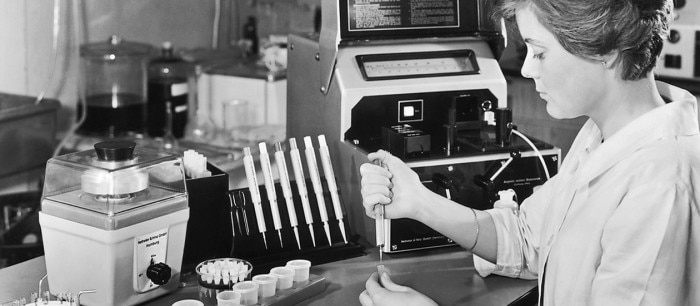MENU
SG | SGD
SG | SGD
No results found
Search Suggestions

60-Year Anniversary of a Pipetting Masterstroke
SIMON PLATE Lab Academy
- Lab Life
- Lab Routine
- Pipetting & Dispensing
- Efficiency
- BioNews article
2021 marks a key milestone for anyone working in a lab. 60 years ago, Eppendorf changed the ways of liquid handling forever with a new product type that enables today’s scientists to talk and pipette simultaneously! In 1958, German physician Heinrich Schnitger at the University of Marburg filed for a patent describing a “device for the fast and exact pipetting of small liquid volumes”. Eppendorf recognized the potential and developed it into the first industrially manufactured piston-stroke pipette.
This article appeared first in BioNews, Eppendorf’s customer magazine since 1993.
Read more
Read less
A world first
Launched in 1961, Eppendorf’s “Marburg Pipette” featured the same basic elements to those found in today’s labs: a spring-loaded piston that stops exactly at a set volume level and a removable plastic tip. This alternative to cumbersome and risky mouth pipetting with glass tube pipettes changed the face of pipetting forever.
The new piston-stroke pipette paved the way for modern clinical analytics and biochemical research by enabling safe, easy, and accurate liquid handling in the microliter range. With its
launch and the complementary reaction tubes (launched in 1963), which are known around the world as Eppendorf Tubes® (or “Eppi®”), Eppendorf laid the foundation of its premium liquid handling business.
Continuing innovation
Since then, by applying our proven expertise and innovation, Eppendorf has continued to set industry standards in precise manual and automated dispensing of small volumes. For example, in 1978, we redefined liquid handling again with the introduction of the Multipette® (US/CAN: Repeater® ) pipette with Combitips® tips system – the first handheld repetitive dispenser and an entirely new concept of disposable tips with integrated pistons.
We have always worked closely with our customers to understand their precise needs and develop the right pipette or solution for every application. Through this partnership, we recognized the growing requirement for increased throughput with the arrival of 96-well plates, and in 1994 launched the Titerman, our first manual multi-channel pipette for high sample throughput.
Still accelerating research
Over the years we have continued to evolve the pipette through the advent of electronic pipetting and automated liquid handling systems for the utmost reproducibility of micro- and nanoliter volumes. And in today’s digital era, Eppendorf is still setting liquid handling benchmarks to meet the needs of future lab work. Our latest introduction in pipetting connectivity – the VisioNize® pipette manager – is designed to redefine speed and workflow management to further accelerate research.
At Eppendorf, we combine state-of-the-art instruments, high-quality consumables, and leading added-value services to ensure that the past, present, and future of pipetting continues in safe hands.
Read more
Read less
Related Documents
- Magazine | BioNews 55 (July 2021)
Read more
Read less
